The Man Behind the Lens
Posted on Sept. 18, 2023IN MEMORIAM
Daniel Currie Sears ’74 | 1951–2023

For more than 30 years, UNC photographer Dan Sears ’74 used grace, humor and thoughtfulness to capture Carolina’s sense of place and to chronicle many of UNC’s historic moments. (Photo: UNC)
James Moeser made his way over to 210 Pittsboro St., across the road from the Carolina Inn. It was summer 2000, and he had just become UNC’s ninth chancellor. Time for an official photo.
Enter Dan Sears ’74, Carolina’s University photographer, whose studio on Pittsboro Street had lights and backdrop at the ready. There was nothing intimidating about the experience. “Dan’s technique was to put the person he was photographing totally at ease,” Moeser said. “He made me relax.”
Such was the talent of Sears, who worked some 25 years in the news business before he joined UNC News Services (now University Communications) in 1992, serving until he retired in 2015. Tributes and memories poured in after Sears died in his sleep on May 25 at his home in Chapel Hill. He was 71 years old.
“He was the recorder for so much of our history,” said Mike McFarland ’82 (’90 MA), director of University Relations at UNC and Sears’ boss for much of their careers.
Sears chronicled many of UNC’s historic moments during the past 30-plus years — the University’s Bicentennial in 1993, when President Bill Clinton and Charles Kuralt ’55 spoke; commencements; University days; thousands of people gathered on Polk Place after 9/11; Coach Dean Smith announcing his retirement; the University’s Tar Heel bus tours; and more. Sears populated news releases, the University Gazette newsletter (now The Well), Carolina Alumni Review and unc.edu with images of the people, places and preeminent events that define Carolina.
“Just think how many people saw the beauty of our campus through Dan’s lens,” said Courtney Mitchell ’01, general manager of The Daily Tar Heel.
Before working for Carolina, Sears had stints at The News Reporter in Whiteville, the Wilmington Star-News, the Associated Press and United Press International, where he captured slices of Southern history. He shot the Masters golf tournaments, a Super Bowl, NASCAR races, Michael Jordan ’86 playing in high school, ACC basketball tournaments, televangelists Jim and Tammy Faye Bakker and space shuttle launches.
“He covered every major event in the South,” said close friend Jamie Moncrief ’85, who worked for Sears at the Star-News and as a freelancer for UPI. “His photography was absolutely spectacular.”
Sears’ photos appeared in some of the nation’s largest publications, including Life and Time magazines, U.S. News & World Report, The New York Times, the Chicago Tribune, USA Today, the Seattle Post-Intelligencer, The Atlanta Journal-Constitution, Vanity Fair, Sports Illustrated, Parade magazine and ESPN The Magazine.
Grace and humor
Justin Smith ’07 owns The News Reporter, where Sears worked summers and every other weekend while a student at Carolina. Smith was Sears’ intern when Smith was a student.
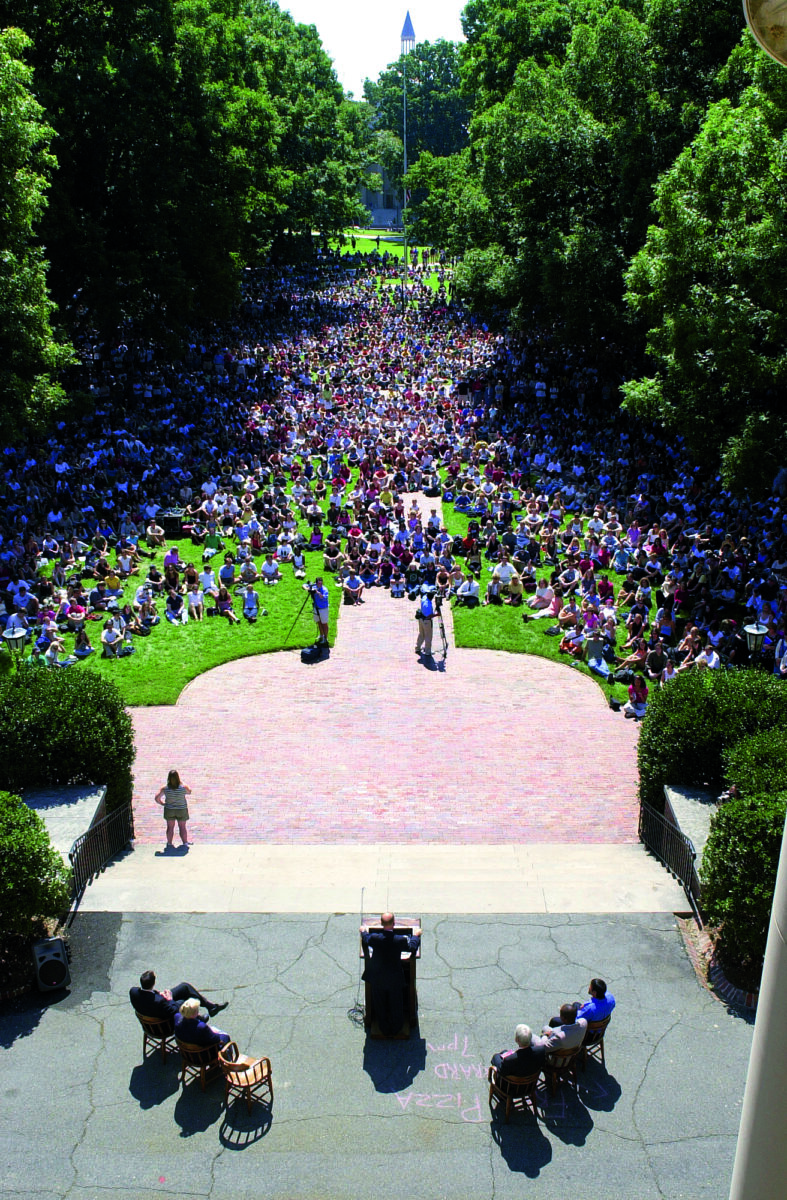
In addition to shooting the everyday moments and annual events that made up the life of the University, Sears was on hand to document the unimaginable and the extraordinary, such as people in the Student Union witnessing the 9/11 terrorist attacks on television and the memorial ceremony held on Polk Place on Wednesday, Sept. 12, 2001. (Photo: Dan Sears ’74)
After a portrait shot in the studio, Smith said, Sears would show the subject the photos on a computer screen, and if the person didn’t like them, he’d shoot them again. “Dan would diagnose what they’re self-conscious about and what it was that they didn’t like,” Smith said.
One of Sears’ most memorable shots was of fireworks bursting behind a silhouetted Bell Tower, the clock face illuminated, during the July 4, 1993, celebration in Kenan Stadium. (See the cover of the July/August 2023 Review.) He risked life and limb on South Road to get the photo. “It was my job to watch the traffic and make sure he didn’t get hit,” said Marisa Sears, his wife. “I don’t think he was on assignment for the University. He decided, ‘Let’s go out there and see what we can get.’ ”
McFarland said Sears meticulously planned shots from a creative and technical perspective, considering time of day, lighting, activity on campus and what equipment or lights he needed.
But much of Sears’ success stemmed from his personality. “Dan could talk to anybody,” Moncrief said. “He could always get us into any event. … People enjoyed being around him because he was so funny. He was wickedly fast when it came to commenting. Dan had a one-liner for every situation.”
In the news business, Sears’ humor was welcome, Smith said. “I think that is really important when so much of what we have to cover is unpleasant. To keep everybody’s spirits up is important.”
Moncrief once heard Sears carry on an entire conversation with a co-worker using quotes from the 1970s blockbuster movie Blazing Saddles. He and Sears covered at least 20 ACC basketball tournaments together, and once during a lull in play, they were standing in line for food when the caterer put down a tray of barbecue that was an unusually bright red. “Dan said, ‘Well, make sure you eat the brownie first because it’s going to have to work like a plug,’ ” Moncrief recalled. “He was always the funniest guy in the room. It might have not always been the most politically correct, but it was the funniest.”
Sears contributed to the success of UNC’s News Services with much more than photos. He created a searchable online database of Carolina images that is still used. And he helped come up with taglines and headlines. One of his most notable was “Roads Scholars” for the first Tar Heel Bus Tour, which transports new UNC faculty and administrators throughout North Carolina in the fall to learn about the state from which most students hail.
Jordan, Bakker, riots, shuttles
Sears grew up in Whiteville, son of a banker and a summer-stock theater actress. He gravitated early to photography. From a small camera and an initial interest, he graduated to a 35mm camera his mother bought him. He set up a darkroom in a shed on the family property. “He would listen to the [police] scanner and go out on calls,” shooting for The News Reporter, Marisa Sears said. Two of his awards still hang on an office wall at the paper.
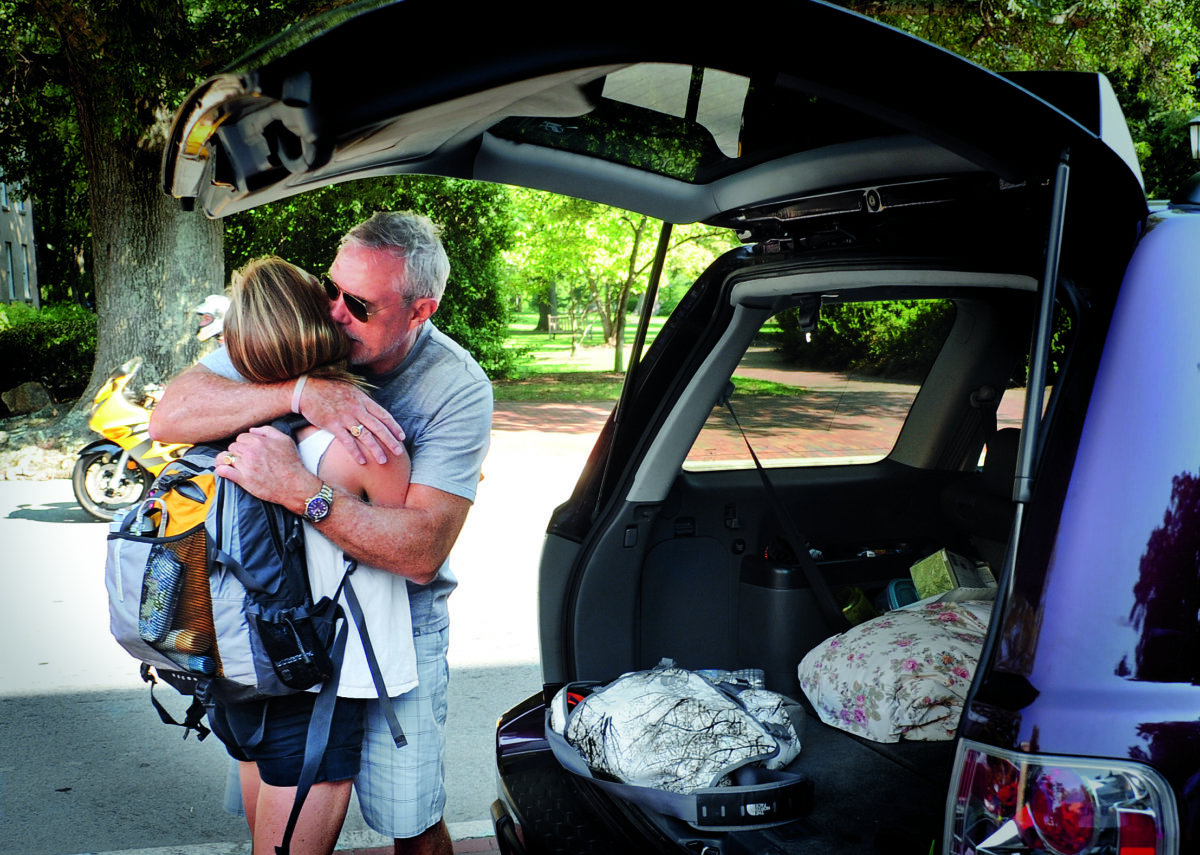
Small goodbyes like the one above happen hundreds of times per semester, and Sears covered them lovingly for nearly 25 years. (Photo: Dan Sears ’74)
Sears found high school boring, Marisa said. “He was so smart that it just didn’t challenge him, so he was always getting into a little bit of trouble.”
His father sent him to The Bolles School in Jacksonville, Florida, his last two years of high school, where he excelled, Marisa said. Then came a degree in journalism from Carolina. After graduation, Sears worked for the AP in Washington, D.C., but he wanted to return to North Carolina.
He landed at the Star-News, where he eventually became chief photographer, and shot a young Michael Jordan playing basketball for Emsley A. Laney High School. Moncrief was a student photographer for nearby John T. Hoggard High School. “I’d stand right next to Dan and shoot right over his shoulder,” Moncrief said. “He would get photographs that blew mine out of the water.”
Sears also shot a photo of Dean Smith, tucked high in the bleachers, when Smith came to scout Jordan.
Sears’ Jordan high school photos have been printed in newspapers, books and magazines. The images were the property of the Star-News, which handled the reproductions. Sears didn’t get a cent, he had said. Gannett Co. Inc., which owns the Star-News, did not respond to requests for comment.
Marisa said she met Sears when “he literally sailed into my life.” Dan was boating with a girlfriend in the Wrightsville Beach area, and he wanted to anchor near where Marisa and her boyfriend were sitting, Marisa said. The two couples became friends, but later Sears and Marisa both “got dumped” by their respective partners, Marisa said.
Then Marisa saw Sears in a store buying a button to go on a tuxedo jacket, because he had to cover a black-tie event for the Star-News. “Let me take care of that for you,” she recalled telling him, and a romance was born.
When Sears left the Star-News, UPI hired him for its Columbia, South Carolina, bureau. Sears shot a photo of televangelist Jim Bakker, host of the Christian television program The PTL Club during the 1970s and ’80s, passing a collection bucket among his audience and people not contributing. In reaction, Bakker’s wife, Tammy Faye, poked Sears in the chest and called him a stinker, Marisa said.
UPI transferred Sears to Miami, where he went “kicking and screaming,” because he loved his post in Columbia, said Marisa, who followed him to South Florida. There, he covered the 1989 riots sparked when a Hispanic police officer shot and killed an unarmed black motorcyclist. The unrest occurred days before the 1989 Super Bowl in Miami, which Sears also covered. Marisa found a bottle of champagne engraved with “Best Sports Photo,” for a Super Bowl picture Sears took. She said the photo appeared on the front page of a section of the Miami Herald. The award came with a monetary prize, which he used to buy Marisa an engagement ring. They were married in 1990.
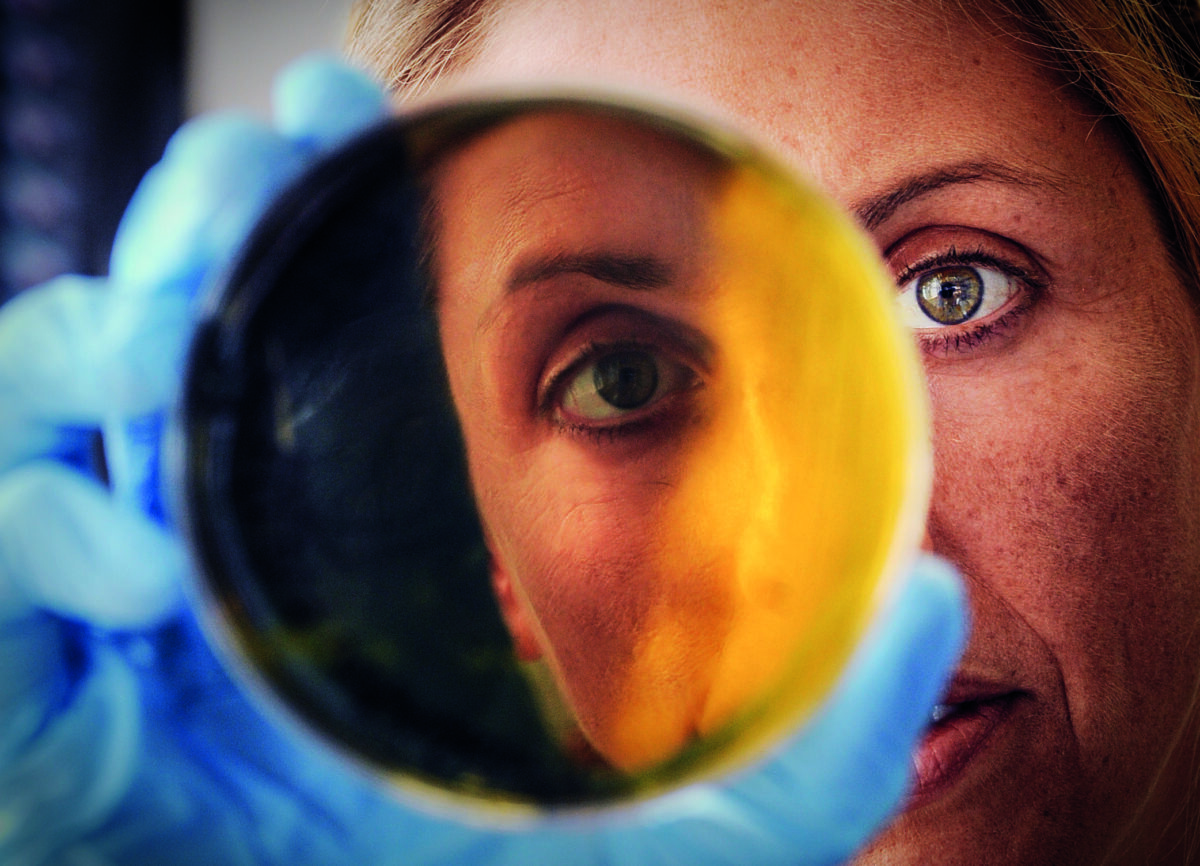
He could also create an intriguing portrait, like this one of Institute of Marine Sciences researcher Rachel Noble. (Photo: Dan Sears ’74)
After an explosion aboard the USS Iowa, which was at sea in the Caribbean, killed 47 sailors, Sears was assigned to shoot the ship limping into a Puerto Rico port. He left “on a moment’s notice with only the clothes on his back,” Marisa said. “He was more concerned with getting the equipment he needed.”
Sears’ career in Miami included some bright spots, including shuttle launches at Cape Canaveral. For his first shot of a takeoff, the wind shifted at just the right moment, and he captured an American flag unfurled to its fullest, with the shuttle launching in the background.
After UPI closed the bureau, Sears told Marisa his favorite picture of Miami was in his rear view mirror as he was leaving.
The essence of Carolina
Sears was running the photography department for the drugstore chain Eckerd Corp. in Charlotte when he learned about the photographer position at Carolina. Moncrief called it Sears’ dream post. “He was very proud when he got that job, and he was damn good at it,” he said.
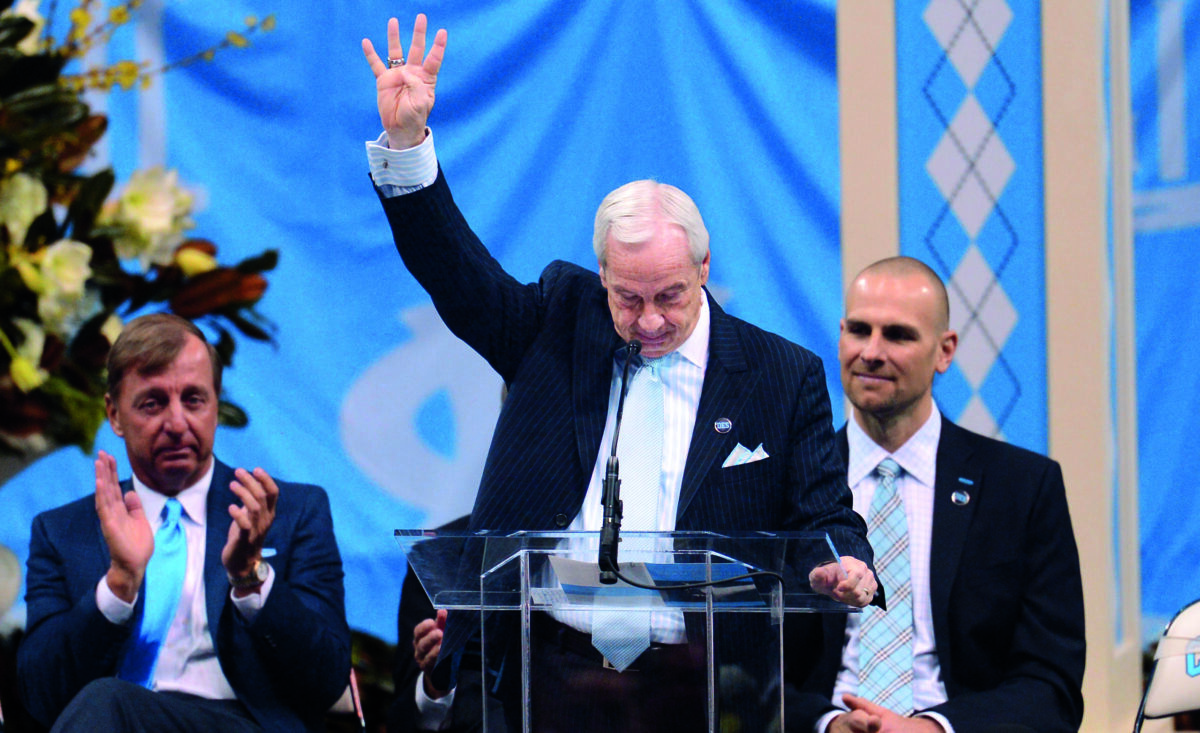
In 2015, Roy Williams ’72 (’73 MAT) made the signal for Four Corners at the memorial service held for coach Dean Smith. (Photo: Dan Sears ’74)
Sears leaned on the knowledge of Carolina he developed as a student to capture the campus and its people. From 2007 to 2015, Patty Courtright ’75 (’83 MA) edited the University Gazette. She never had to mention that she needed a spring picture. “He knew exactly when each tree was going to be in bloom,” she said.
If Courtright needed to depict a faculty member’s research, she would discuss it with Sears, “then it was Dan’s expertise to decide how to illustrate that,” she said.
Sears’ sensitivity toward the University and his subjects was paramount. “He would look at a scene and go, ‘Is there anything that might offend somebody, anything we should not shoot about this?’ ” Marisa said.
In his off hours, Sears enjoyed the couple’s two Maine Coon cats and watching old movies with Marisa, the two taking turns quoting lines. He became a ham radio operator, hurrying to learn Morse code before it was no longer required. He broadcast all over the world and exchanged postcards with his far-flung friends.
In retirement, Sears enjoyed reading books about World War II and shooting scenes that are disappearing from the South, such as old tobacco barns, with his beloved Hasselblad cameras. He printed the photos on cards and bookmarks for friends.
But beyond the photos, people remembered Sears’ character. “He was absolutely one of the truest people I’ve ever known,” Courtright said. “There was no pretense about him. He was professional and courteous. … His guide star was his ethics. He believed in honesty and hard work.”
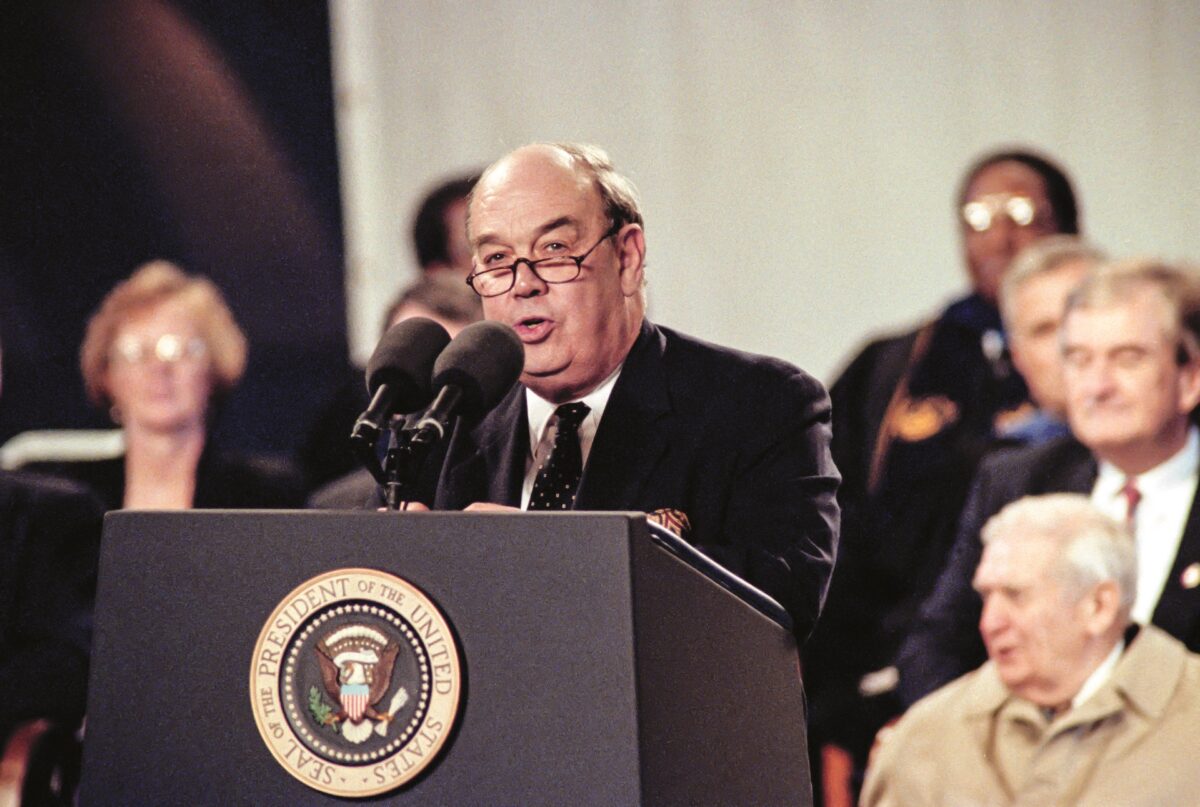
Charles Kuralt ’55, along with Bill Clinton and other dignitaries, was on hand for the University’s Bicentennial celebration in 1993. (Photo: Dan Sears ’74)
Moeser said he doesn’t think Sears had any enemies. “He was really kind and considerate and thoughtful,” he said.
McFarland called Sears “a very kind man with a big heart and an even bigger laugh who was extremely dedicated to his work.
“He truly captured the very essence of our campus and the Carolina spirit — the sense of place, the emotions and humanity of the people, the physical beauty and our mission. Dan loved Carolina and was passionate about showing the very best of this place.”
Laura J. Toler ’76, a freelance writer in Durham, worked with Dan Sears for 15 years at Carolina News Services, now University Communications.
Thanks for reading the Carolina Alumni Review
Carolina Alumni members, sign in to continue reading.
Not yet a member? Become one today.
